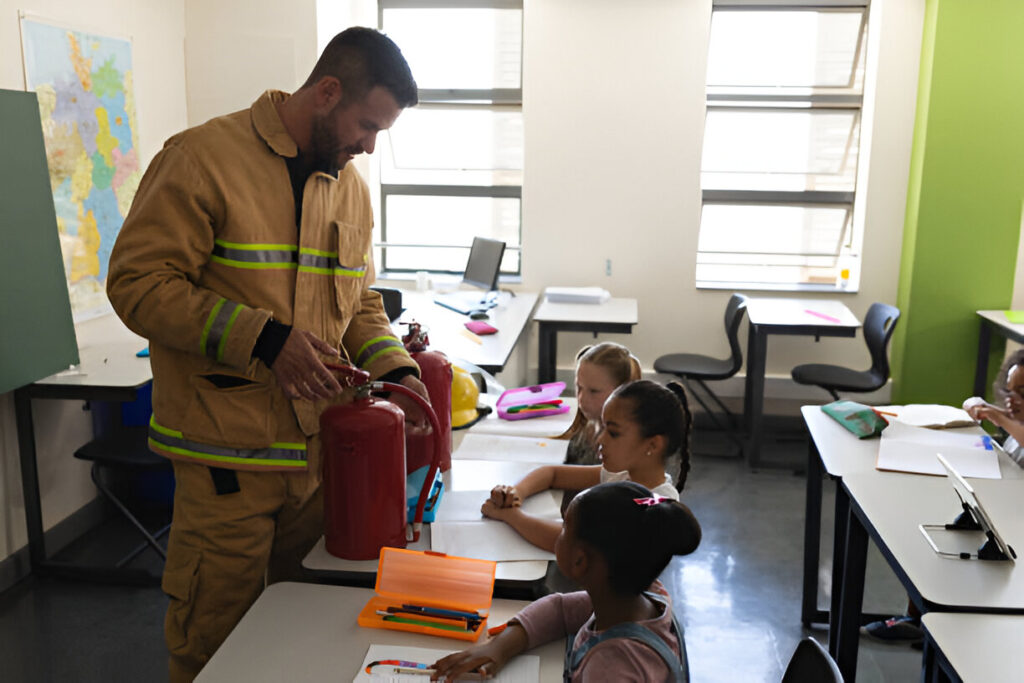Fire safety in schools goes beyond meeting regulations. Every student and staff member should be protected from fire hazards and trained personnel play an important role in maintaining a safe environment. Fire warden training provides designated individuals with the knowledge and skills needed to respond effectively in emergencies. Trained staff can help manage fire risks and promote safety awareness.
This guide outlines key fire safety strategies for schools, including structured fire warden training, to support a secure learning environment.
Understanding the Role of a Fire Warden in Schools
Schools have a duty to uphold fire safety standards, and fire wardens play a crucial role in ensuring that emergency procedures run smoothly. These designated staff members receive specialised training to manage fire-related incidents, coordinate evacuations and monitor safety measures within the school. Their responsibilities include keeping escape routes clear, ensuring fire safety equipment is maintained and acting as a point of contact during emergencies.
Fire warden training gives them the skills and confidence to respond effectively under pressure. They learn how to assess fire risks, implement preventive measures and assist students and staff during evacuations. Beyond emergency response, they also help create a culture of fire safety, ensuring that everyone in the school is aware of the risks and knows how to act in an emergency.
Having well-trained fire wardens in place improves response times during critical situations and strengthens overall school safety. With proper training and regular refresher courses, fire wardens can help reduce fire hazards, maintain order during evacuations and support a safer learning environment for everyone.
Why Is Fire Safety Training Necessary?
Fire drills and safety education are essential for keeping schools safe. A strong fire safety plan ensures that staff and students know how to react in an emergency. Schools must go beyond the basics by integrating fire safety into daily routines, using modern technology and working with local fire services. Moreover, fire safety training ensures that these key personnel are not only ready to act in case of an actual fire but also well-versed in preventive measures to reduce the risk of fire.
Key Components of Fire Safety Education
Fire safety training in schools should go beyond basic instructions like ‘stop, drop and roll.’ Every student and staff member needs to recognise fire hazards and understand how to react quickly in an emergency. Regular training sessions, hands-on workshops and fire drills should be a key part of this education to reinforce knowledge and build confidence in emergency situations. Embedding fire safety into the school curriculum helps instil awareness from an early age, making safety a lifelong habit.
Fire Safety Regulations for UK Schools
UK schools must follow strict fire safety regulations, including conducting regular risk assessments and maintaining clear emergency procedures. Schools are responsible for keeping fire safety equipment in working order and ensuring that escape routes are unobstructed and clearly marked. Adhering to these regulations is more than just a legal obligation—it’s a fundamental duty to protect students and staff, creating a secure learning environment.
Implementing Effective Fire Drills
Regular fire drills train students and staff to respond quickly and correctly during an emergency. These drills should be realistic, covering different scenarios and taking place at unexpected times. A well-practised evacuation plan makes fire response instinctive, reducing panic in real situations.
Teaching Fire Safety in the Classroom
Fire safety should be part of the school curriculum, not just a one-off lesson. When students understand the risks and know how to react, they become more prepared. Lessons should be tailored to different age groups, using interactive activities like quizzes and group discussions to reinforce key messages.
Using Technology to Improve Fire Safety
Modern fire safety technology plays a crucial role in preventing and managing emergencies. Smoke alarms, fire suppression systems and emergency lighting all help reduce risks. Schools should invest in these tools and train staff on their proper use. Keeping fire safety equipment up to date is just as important as conducting drills.
Going Beyond Basic Preparation
A fire safety plan should cover more than just drills and alarms. Schools should have clear communication plans in place for emergencies. Safety kits with first aid supplies and essential tools should be readily available. Training staff in crisis management and first aid can also strengthen the school’s emergency response.
Working with Local Fire Services
Partnering with local fire services gives schools access to expert advice and training. Fire professionals can conduct safety audits, offer training sessions and keep schools informed about the latest fire prevention techniques. These collaborations help ensure that fire safety procedures remain effective and up to date.
Keeping Fire Safety Policies Updated
Fire safety policies need regular reviews to stay in line with legal requirements and best practices. Schools should assess their safety measures periodically and update procedures when necessary. Consulting fire safety professionals and local authorities can help refine policies and keep them relevant.
Summary
Effective fire safety measures help safeguard students, staff and school facilities. Online fire safety training provides key personnel with the knowledge and skills needed to handle fire-related emergencies. Keeping fire safety policies updated and working closely with fire services further improves a school’s ability to prevent and respond to potential risks.
Prioritising fire safety allows schools to comply with legal requirements while showing a strong commitment to the well-being of their staff and students. Taking a proactive approach reduces fire hazards and ensures that everyone on campus understands how to respond in an emergency.

